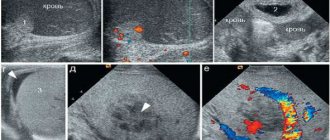In the previous article, we briefly talked about the common hepatitis A, B and C viruses and the importance of their early diagnosis. Viruses that cause inflammatory liver diseases, despite the fact that they have the same target organ, differ in structure and clinical manifestations. Therefore, the diagnosis of each hepatitis (C, B, G and D etc.) has characteristic nuances associated with their special properties.
Special properties of hepatitis B:
- The genetic material - the main part of the virus - is represented by a double strand of DNA.
- It is also called “serum hepatitis” because it only takes a very small amount of virus to enter the bloodstream for infection. That is, the volume of infected blood for transmission of the virus may be very small.
- The high risk of infection was one of the reasons why vaccination against hepatitis B was included in the immunization calendar and is given to children, medical workers and is recommended to everyone else.
- It especially often becomes chronic in children.
- It is a helper virus for the existence of hepatitis D. Without it, delta hepatitis is not viable.
- The most dangerous is the fulminant form of the disease, which leads to rapid mass death of liver cells and the development of coma; in most cases, it develops due to a combined infection with hepatitis B and D.
Special properties of hepatitis C:
- It is also called the “neither A nor B” hepatitis virus. Unlike the type B pathogen, this one contains all of its genetic material in a single strand of RNA.
- The antigens of the virus are in very low concentrations in the blood, which creates serious difficulties in its detection.
- Sometimes called “post-transfusion hepatitis” because infection often occurred through blood transfusions.
- It is considered the most dangerous form of viral hepatitis for health, contributing to the development of liver cancer and fibrotic changes in the organ.
- The hepatitis G virus in combination with the hepatitis C virus can cause cirrhosis of the liver. The combination of these two viruses worsens the prognosis, despite treatment.
- It is rarely accompanied by jaundice and a rise in temperature, unlike hepatitis B. Therefore, the acute phase of hepatitis C can masquerade as food poisoning, flu, etc.
Special properties of hepatitis D and G:
- The delta hepatitis virus (D) is capable of reproduction and active life only if there is already infection with hepatitis B. Together they form more severe forms of organ damage (including fulminant), creating serious difficulties in treatment and increasing the destruction of liver cells.
- The type G virus is considered an independent causative agent of hepatitis. Manifestations may be similar to infection with the C virus, but the disease is milder. Can occur in acute and chronic forms. Very often found in combination with hepatitis C RNA, which worsens the prognosis of the disease.
- Infection with hepatitis D and G is especially likely for injection drug addicts, lovers of tattoos and piercings at home, as well as in promiscuous sexual relationships.
- Early detection of these two types of viral hepatitis is of great importance for predicting the further development of the disease and selecting a treatment regimen. For this, the most accurate method for identifying viral particles is used - PCR.
When is laboratory diagnosis necessary?
It is only possible to accurately diagnose viral hepatitis and determine its type using laboratory diagnostics.
Viral liver damage can be suspected if:
- Flu-like symptoms (weakness, fever, muscle pain). Sometimes they are the only manifestations of the acute phase of the disease, especially when infected with hepatitis C or G.
- Symptoms similar to rheumatoid diseases - aches and pain in the joints.
- Pain in the right hypochondrium, jaundice, darkening of urine and discoloration of feces.
- Periodically disturbing nausea, vomiting, causeless weakness, which intensifies in the evening.
Therefore, it is recommended to test for hepatitis B and C, D and G if you are concerned about such symptoms and there are no other known causes for their occurrence.
Types of hepatitis
Not only viruses, but also parasitic microorganisms, pharmacological agents toxic to the liver, as well as a malfunction of the immune system can provoke the development of hepatitis. Depending on the nature of origin, renal anomalies are divided into five types.
Variations of hepatitis:
- Botkin's disease (A) is the most common type of disease. It is characterized by a long incubation period from 7 to 50 days. A patient who has recovered from this form of hepatitis develops immunity to all other types. B (HBV) - has a 10% permanent threshold. Symptoms may be similar to acute respiratory infections. The incubation period of the virus is about 2-3 months.
- C (HCV) – in 80% of cases the anomaly becomes chronic. Symptoms appear after a week, sometimes after 3 months. The disease can be combined with other types of hepatitis. There is no vaccine for this type of kidney pathology.
- D (HDV) – often develops simultaneously with hepatitis B, the disease severely affects the liver. The latency of the disease is up to 7 weeks.
- E (HEV) - this type of hepatitis is extremely dangerous for pregnant women. In most cases it is fatal. Residents of Africa and Central Asian countries are at risk.
Any variation of hepatitis is dangerous to health and requires proper treatment. Timely vaccination will help avoid the consequences of liver diseases.
Immunological method
Aimed at detecting antibodies to the virus that the immune system produces, as well as identifying antigens (parts of the virus itself) in biomaterial. The method allows you to estimate the titer of antibodies and antigens (the concentration of these particles in the blood plasma). Based on these data, one can also judge the activity of the virus and the dynamics of changes. But the technique has a higher error rate.
Tests for hepatitis can perform different tasks:
- Qualitative analysis is aimed at establishing the presence of viral material in the blood.
- Quantitative analysis for hepatitis C and B determines the concentration of the virus in the blood, which is important for the selection and adjustment of therapy.
Where can I donate blood for hepatitis?
Our laboratory is equipped with modern equipment that provides fast, detailed results. We guarantee reliability, anonymity and high accuracy of the analyzes performed. In addition, we can conduct a hepatitis test at prices affordable to everyone.
In order to not give the disease a chance to cause irreparable damage to your body, it is necessary to timely check your blood for markers of viral hepatitis. We have created all the conditions so that you can anonymously test for hepatitis without wasting time and money.
How many times should I be tested for hepatitis if the result is positive?
Since viral liver disease has serious consequences and requires the use of certain medications, the diagnosis must be accurate. Therefore, after the first positive test result for hepatitis, an additional confirmatory test is required.
The first test for hepatitis B, C, D, G can be carried out using an immunological method, which is aimed at detecting virus antibodies in the blood. If the result is positive, a high-precision PCR test helps confirm or refute the suspected diagnosis. The genetic PCR method allows you to estimate the number of viral particles in the blood (indicators of “viral load”). This data is used to select treatment and monitor its results.
If the result is negative:
- Act in accordance with the recommendations of your doctor. If there are still suspicions of viral liver damage (symptoms, results of other examination methods), it will be possible to repeat the analysis or perform a diagnosis using PCR instead of determining antibodies in the blood.
- It is also necessary to be examined for hepatitis if there are risk factors for infection - injections and injuries with non-sterile sharp objects that are not objects only for your use (needles, scissors, etc.), blood transfusions, tattooing and piercing, regular visits to manicure and pedicure procedures in salons and masters at home, etc.
Features of diagnosing hepatitis C and B:
- There is a very small amount of hepatitis C antigen in the blood compared to type B virus. Therefore, PCR diagnostics is preferable for an accurate diagnosis of hepatitis C and monitoring the dynamics.
- Chronic hepatitis B and C can pass for a long time with minimal clinical manifestations or be completely asymptomatic until large-scale irreversible changes occur in the liver. Therefore, viral liver lesions are often discovered by chance - during routine examinations, examinations before hospitalization for other reasons, etc.
- If there is doubt about the diagnosis, the analysis must be repeated, as in rare cases false negative results are possible.
- After the first positive blood test for hepatitis C and B, a repeat test is required to confirm or exclude the diagnosis.
- You should remember these features if you are concerned about health problems, but you put off visiting a doctor, considering them minor or temporary.
Causes and methods of infection with hepatitis
Botkin's disease is transmitted through household contact with household items, dirty hands and unwashed foods; in general, it has a fecal-oral route of transmission. Hepatitis A goes away quickly and without noticeable consequences. Other variations of the disease belong to the parenteral group (C, D, and so on); they may not manifest themselves for a long time, but subsequently torment a person throughout his life, contributing to the development of cirrhosis or even liver cancer. Transmitted mainly through blood during transfusion.
Methods of infection with hepatitis:
- Intrauterine route - transmitted from mother to fetus.
- The use of one syringe by many people is the main way of infecting drug addicts.
- Sexual intercourse is how hepatitis B is mainly transmitted.
- If non-sterile instruments were used during ear piercing or tattooing.
- Impact of toxic substances on the body, etc.
The symptoms of each variant of hepatitis are different; almost always the patient feels fatigue, a headache may appear and the temperature may rise. During the progression of Botkin's disease and other types of illness, yellowness of the skin occurs. A blood test helps identify the disease.
Examination for viral hepatitis and suspicion of it
If you suspect liver disease, it is necessary to undergo examination under the guidance of a specialist. The doctor, having assessed your complaints and symptoms, will provide you with a list of tests that you need to undergo. The final diagnosis is formulated only on the basis of a combination of examination data, laboratory and instrumental diagnostics:
- Determining the presence of a virus or antibodies to it, as well as assessing the “viral load”, identifying the characteristics of the virus (immunological method and PCR method).
- Determination of biochemical indicators of liver condition. Liver enzymes ALT and AST, protein, bilirubin, alkaline phosphatase, etc. are assessed. Changes in these indicators give an idea of the signs of liver cell destruction and the degree of disruption of its normal functions.
- Visualization of the condition of the liver tissue. Usually carried out using ultrasound, MRI, elastography (using the Fibroscan device). Allows you to see the area of organ damage, signs of fibrotic changes, and the appearance of neoplasms. For a more detailed assessment of the condition of the organ, a liver biopsy is performed
- Detailed general blood test, assessment of coagulability (coagulogram). Changes in these indicators can also give the doctor important information about the condition of the liver, since this organ takes part in the synthesis of components of the blood coagulation system.
- Additionally: hormone analysis, tests for autoimmune diseases. As you plan and administer treatment, your doctor may need to evaluate your thyroid function and other endocrine functions, and also look for the presence of rheumatoid factor.
Laboratory diagnostics is absolutely indispensable for viral hepatitis (C, B, D, G). At Lab4U you can undergo a full list of necessary tests at affordable and competitive prices:
- Qualitative and quantitative analysis for hepatitis B, C, D, G (PCR and immunological methods)
- Hepatitis C genotyping (important for prescribing treatment)
- Detailed biochemical blood test with liver tests
- Detailed general blood test, coagulogram, tests for hormones (thyroid gland, etc.), rheumatic factor, etc.
What to do on the eve of the test?
If the patient was taking specific treatment that may affect the result obtained, then the course must be completed at least two weeks before blood sampling, and in some cases earlier.
During the day you must refrain from drinking alcohol, as well as fried and fatty foods. Ethyl alcohol and fatty acids are processed primarily in the liver, which creates an additional burden and can affect the test results.
12 hours before going to the laboratory you need to completely stop eating. At the same time, it is advisable to limit physical activity, and also not to carry out surgical interventions and other instrumental diagnostic methods and physiotherapeutic procedures.
One hour before donating blood, you should not smoke, although a 12-hour abstinence from tobacco is considered optimal.
It is better to spend the last quarter of an hour immediately before the analysis in a calm environment, for example, sitting in the laboratory reception area.
Hepatitis C: what a patient needs to know
Hepatitis C is one of the most insidious and deadly viruses. In 90% of cases, they are asymptomatic. Due to its ability to disguise the true cause under the guise of many other diseases, it was nicknamed the “gentle killer.” If the disease does make itself felt, its active phase is divided into two main periods: pre-icteric and icteric. In the first (early) period, symptoms characteristic of viral infections are observed, such as:
- general weakness;
- skin itching;
- digestive disorders: nausea, vomiting, diarrhea;
- increase in body temperature up to 38°C;
- headaches, myalgia, arthralgia.
In the second (icteric) period, when the liver is affected, a large amount of bilirubin, a yellow pigment, is released into the blood. It is thanks to the icteric staining of the patient’s skin that it becomes obvious that he has obvious problems with the liver, and a set of laboratory tests of blood, urine and feces is prescribed.
However, many cases of infection are asymptomatic, without a characteristic clinical picture. After an incubation period, which lasts from a couple of weeks to a couple of months, the patient may not even suspect that he is a carrier of the virus not only in the prodromal (pre-icteric) stage, but also in the icteric stage - due to its absence as such. For example, in 2/3 of all cases, hepatitis C occurs in an atypical (anicteric, or subclinical) form.
Indications for analysis
A blood test for hepatitis is prescribed for the following symptoms:
- The appearance of pain in the right hypochondrium.
- Severe weakness.
- When the temperature rises.
- When urine darkens.
- With jaundice of the sclera and skin.
Doctors refer the patient for examination in the following situations:
- When surgery is required.
- When unprotected sexual intercourse has taken place.
- When symptoms of viral hepatitis appear.
- When examining drug addicts who inject drugs intravenously.
- In preparation for conception and birth of a child.
- If, according to test results, an increase in ALT and AST is observed.
- Before parenteral procedures.
- In cases where it is necessary to determine the characteristics of the development of pathology, with an already established diagnosis.
Blood donors and pregnant women are required to undergo examinations upon registration and shortly before giving birth. If a patient is at risk for this disease, a study is also prescribed. This means that the person has been in contact with a sick person or may be a carrier of the virus.
How is the analysis carried out?
Diagnosis of hepatitis using blood becomes possible from the fifth week from the moment of infection. Blood serum is examined for HBS and HCV. The material is collected from the ulnar vein; if necessary, material for research can be taken from the wrist.
When testing blood for viral hepatitis, the serological method is widely used. In this case, structures consisting of antigen and antibody paired are studied.
To determine the aggressiveness of the pathogen, blood is taken twice. Seven days after possible infection and ten days later. Based on the changed level of the pathogen, the development of pathology is judged and treatment is adjusted.
If the genetic material of the virus is detected in the serum, the fact of the disease is considered fully proven. At the beginning of the disease, the use of this method is ineffective, since there are still no traces of the presence of the virus in the body.
With this method, it is possible to determine the level of microbes in the blood. In addition to blood, other biological fluids are also used in a similar method to confirm pathology.







